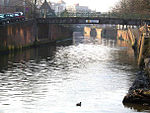Kortrijk ( KORT-ryke, Dutch: [ˈkɔrtrɛik] (listen); West Flemish: Kortryk or Kortrik; French: Courtrai [kuʁtʁɛ]; Latin: Cortoriacum), sometimes known in English as Courtrai or Courtray ( koor-TRAY), is a Belgian city and municipality in the Flemish province of West Flanders.
With its 79,000 inhabitants (2023) Kortrijk is the capital and largest city of the judicial and administrative arrondissement of Kortrijk. The wider municipality comprises the city of Courtrai proper and the villages of Aalbeke, Bellegem, Bissegem, Heule, Kooigem, Marke, and Rollegem. Courtrai is also part of the cross-border Lille-Kortrijk-Tournai metropolitan area.The city is on the river Leie, 42 km (26 mi) southwest of Ghent and 25 km (16 mi) northeast of Lille. Mouscron in Wallonia is just south of Courtrai.
Courtrai originated from a Gallo-Roman town, Cortoriacum, at a crossroads near the Leie river and two Roman roads. In the Middle Ages, Courtrai grew significantly thanks to the flax and wool industry with France and England and became one of the biggest and richest cities in Flanders. The city is often referred to as City of Groeninge or City of the Golden Spurs, referring to the Battle of Courtrai or the Battle of the Golden Spurs which took place on 11 July 1302 on the Fields of Groeninge in Courtrai. In 1820 the Treaty of Kortrijk was signed, laying out the still-current borders between France and Belgium. Throughout the 19th and 20th century, the flax industry flourished and remains important within the Belgian textile industry today.
Courtrai is the largest city in southern West Flanders, with several hospitals, colleges and a university. Courtrai was the first city in Belgium with a pedestrian shopping street, the Korte Steenstraat.











